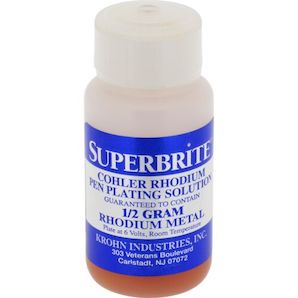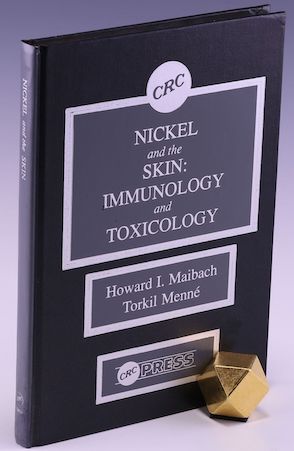
-----
Problems in Rhodium Plating: Black spots, brown spots, blue spots
Q. Hello there !
Are there any additives or brightener solutions and compounds that may be added to prolong the life and improve the rhodium bath solution. My rhodium solution is giving a dark tinge plated surface even though the solution is new and relatively less used (i.e., not many rings of plating of more than 25 seconds have been made, 200 maximum) The bath is a Degussa J2.
Regards,
Pragnesh ZaveriJewellery manufacturing - Bombay(Mumbai), Maharashtra, India
2003
A. The bath is a proprietary product. You need to ask the bath manufacturer. With that little metal plated, it is no wonder that there are so many letters complaining of rings that turn yellow in a few weeks.
James Watts- Navarre, Florida
2003
A. I have several-years experience with Degussa J2, which worked very good without any special additives (except for sulfuric acid -- according to analysis). To obtain bright white coatings, the parts (e.g., rings) must have an active surface -- i.e., freshly nickel plated, or freshly cleaned plus acid dip, etc., always with thorough rinse. It is also necessary to use titanium anodes, platinum plated (or clad)at least 3 microns Pt, and tank should have lining made of virgin PE to prevent spontaneous decomposition of bath. Dark deposition can be caused by small amounts of impurities -- typically copper. It is necessary to avoid contamination of Rh baths with all metals (which can come from fallen parts , or dissolving parts with poor electrical contact during plating).
FRANTISEK HAASglass products - Jablonec n.N., Czech Republic
2003
A. According to a hand book, container should be glass. Contamination with organics can cause black plating, low efficiency, grey or dark plating, low rhodium or contamination. If the parts are not properly rinsed, or not activated, plating would be stained. Solution contamination with (very small amounts) silver or bismuth increases reflectivity. Parts should go into power on tank, and agitated. HOPE THIS HELPS.

Khair Shishani
aircraft maintenance - Al Ain, UAE
2004
Q. Hi,
I am a manufacturer of gold casting jewellery , where we use J2 Rhodium for plating.The problem I face is that after substantial use of the solution, even when life of solution is not over, the coating seems to be dark. The brightness of the coating decreases with use.
Please also suggest me how to work with Replenisher solutions.
Thank you
Paresh Jain- Mumbai, Maharashtra, India
2004
Multiple threads merged: please forgive chronology errors and repetition 🙂
Q. Hi, I have a problem with Rhodium electroplating. It has some black spots left on the finished products. Please help.
J. Tieu.
PS: I used 2-3.5 Volts @ 30 °C when plating. Where can I get the testing kit for the plating solution? Eg: acid, PH level.
Jack TieuStudent - Sydney, New South Wale, Australia
2004
2004
Q. We are currently using Rhodium J1 Solution for electro plating. We have a problem: after plating there are Black spots and yellowish marks.
Plating conditions are --
Anodes: Platinised Titanium
Bath Tank : Plastic
Voltage : 3 - 4 Volts
Current density : 0. 5 - 1 A/ dm2
Time of exposure : 1 min - 2 min for rings.
Bath agitation : 5- 10 cm/s
Bath preparation and other conditions are according to conditions specified by the plating solution manufacture.
Kaushal PathiranaPlating Shop - Galle, Sri Lanka
A. Black spots in plating are usually caused by contaminants in the plating solution, often tramp metals. The supplier of the rhodium plating solution should be able to provide guidance though.

Ted Mooney, P.E.
Striving to live Aloha
finishing.com - Pine Beach, New Jersey
Ted is available for instant help
or longer-term assistance.
2004
A. Dear Kaushal
Improve your pretreatment and switch to j-2 in place of j-1 because in j-1 there is no wetting agent it is for barrel plating and in vat due to lack of proper agitation it gives black spot.
Thanks,
Qutub Saify- Ajman, UAE
2004
Jeweler getting brown spots in rhodium plating
Q. I am a jeweler who is looking for help with answering a question about rhodium plating. Lately my co-worker and myself have been experiencing a problem with brown spots in our plating on rings. We have tried completely changing the bath, changing the voltage, movement and no movement in the bath, changing anodes and hooks, using platinum anode and hook, platinum anode and white gold hook, platinum anode and copper hook and sterilizing all equipment. We are still (after all this) experiencing trouble. Can anyone please shed some light for us. I'm getting pretty frustrated and am at the end of my rope.
Stacy Jonesjeweler - Greenfield, Indiana, United States
2004
|
A. Except in extremely clean conditions and then only with very special proprietary electrolytes, all rhodium is deposited with cracks. Copper and Silver migrate right through the cracks and show up as brown (copper) or gray to black (silver). Put nickel under the rhodium as a diffusion barrier.  Robert H Probert Robert H Probert Technical Services Garner, North Carolina  2004 A. This problem happened to me also until I put the ring into a cleaning concentrate called TIVACLEAN by Krohn. I hope this information will help you. David Zobalijeweler - New City, New York 2004 |
Multiple threads merged: please forgive chronology errors and repetition 🙂
Help! rhodium plating troubleshooting!
2005Why my platinum anode and platinum plating wire which being used to hang the item are always having a black spot after I plated several items?
My cleaning process:
-after polishing, I use ultrasonic machine
-boil the item
-electrocleaning using 35 grams tri-sodium phosphate solutions for 1 minute
-rinse in water
-dip in 10% sulfuric acids for 1 minute
-rinse in distilled water
-dry the items
-ready to plated
Condition of the rhodium plating:
-100 Fahrenheit
-3 volt
-anodes:platinized-platinum (mesh)
-cathode:platinum or 18K
Please help me.
thank's
Pantes - Cirebon, Indonesia
Hello Hendy,
You did not mention that you had any problems with the plated part, which is the most important thing. It would be a good idea to have the solution checked for metallic impurities. Sounds like the unwanted metal present in the bath is oxidizing. Do you have adequate solution agitation? A filter pump is worth it's weight in gold, and you can carbon polish the bath periodically using carbon filter tubes, which would keep organic contamination down. Your rhodium supplier should have a procedure for precipitating metallic impurities so you can purify the bath yourself if need be. Let me know how you make out.
process engineer - Malone, New York
2005
Q. Hello,
We are a small jewelry company which has been experiencing very frustrating rhodium issues lately. We have been getting black spotting all over our pieces when we go to rhodium. We have tried replacing everything in the process from the anode, to the acid to the electrocleaner to the rhodium to the metal clips ... nothing helps. We tried variable dipping times, temps, and voltages ... no help. We need any assistance to this issue and can supply pics if needed. Thanks!
jewelry - Los Angeles, California
2006
|
A. Ramy, Process Engineer - Syracuse, New York 2006 2006 A. Rhodium process is very acidic and plating efficiency is very low. During plating, lots of hydrogen gas generate on cathode. Your problem could be gas bubbles attach on jewel surface and cause pitting.  David Shiu - Singapore A. Rhodium over what? If over silver, then the silver is migrating through the cracks in the highly stressed rhodium and galvanically corroding on top.  Robert H Probert Robert H Probert Technical Services Garner, North Carolina  2006 |
Q. Thank you to all who responded here. Let me clarify my situation in more detail now as I should have done in the first place. We make jewelry pieces at our shop in 18 kw / palladium.
We have a plating section set up in our shop to plate rings one at a time. The Rectifier is a 30 amp with brand new alligator clips. 600 ml Pyrex beaker [beakers on
eBay
or
Amazon [affil link] s for all our solutions. Stainless steel anode which has been cut in length a little to fit one beaker for the KROHN Heavy duty electro solution. 1 gram of rhodium solution (acid based) in another pyrex beaker with a platinized titanium anode. Clean Earth Dry Acid Salt solution in another beaker for surface preparation between the electro-clean stage and the rhodium stage. Between each stage after the electro-clean there is a beaker filled with Distilled water to rinse off the piece.We also have tried air-can drying the piece between the last dip in distilled water and the final rhodium plating stage.
We have tried every conceivable procedure including buying the anodes, clips, rhodium and electro-clean solutions one time over to ensure there was no contamination problem. We have tried varying volts (1-3 volts ) and times (10-25 seconds) making sure not to burn the rhodium in the process and used heating plates at the recommended temperatures for both the rhodium solution and the electro cleaner alternatively.We have plated the piece over as well with the results too negligible to make a difference. Also we make a thorough ultrasonic cleaning before hand and steam the piece properly before attempting to plate , using a white gold hook on the alligator clip to make the transfer over to the plating section. We never handle the piece by hand after the steaming process until the piece has completed the plating process.All beakers have a rubber stopper that fits airtight to protect from evaporation and contamination.
Thinking it could be our type of alloy in our gold (palladium), we tried using other mixtures of alloyed golds... the same result always ensued. An evenly distributed pattern of tiny brown/black spots over the entire piece. It is hard to see in certain types of lighting but under some lighting it becomes quite apparent. Almost like a leopard pattern I'd say.
- Los Angeles, California
2006
|
A. Hi Ramy, Process Engineer - Syracuse, New York 2006 A. I would suggest that you replace the rhodium solution with another product completely. Next if you are steam cleaning the jewelry before plating, stop this practice, you are introducing contaminants if it is hooked to the city water supply. Metal Arts Specialties - Leonard, Michigan 2006 |
A. I think your rectifier is too much, even at 1.0 volt you are drawing too much current( a lot of gassing) for one ring. Get yourself a 0-10 amp meter with .2 amp graduations.
connect to the cathode side. Start with 1.0 amp,3.0 sec. ,rhodium solution at room temperature. moving the ring back and forth for agitation( not too fast it is jumping off the hook.Check your piece for coverage, increase current or time as needed. If problem persist cut back on current. Check pieces for coverage, increase time as needed.
Make sure to electroclean(cathodic -),rinse, hot pickle, rinse, Plate.
Emery out old rhodium plate before polish.
Good luck.
- Mays Landing, New Jersey
2006
2006
A. I get black spot problem if I have not melt properly.
Black spot problem I get in Ni base alloy white gold rings but I solve that problem by nickel plating and then Rh plating.
Rh should be at least 2 g per liter and plating time should be 120 seconds at least.

Dipen Pattni
jeweler/goldsmith - Dar-Es-Salaam, Tanzania
|
A. Dipen, Process Engineer - Syracuse, New York 2006 A. Hi,  Dipen Pattni jeweler/goldsmith - Dar-Es-Salaam, Tanzania 2006 |
A. Hi Ramy
I suggest you verify the porosity and if its actually porous cast material, I would suggest you Plate a WHITE BRONZE bright layer first.
That's NON allergic.
Then Plate with Rhodium . The Bath should use Platinised Ti anodes and you must move the component around between the anodes to build up a solution flow past the piece.
Or use a Magnetically stirred heater.
This is how lots of people deal with Porous castings.

Asif Nurie [deceased]
- New Delhi, India
With deep regret we sadly advise that Asif passed away on Jan 24, 2016
2006
A. One thing that stands out is that you said you are using a stainless steel anode. This may be causing the problem. You should be using a platinum or platinized titanium anode for rhodium plating. Double check your anode material.
Good luck,
Refining & Alloys - Alden, New York
2006
(you are on the 1st page of the thread) Next page >
Q, A, or Comment on THIS thread -or- Start a NEW Thread


